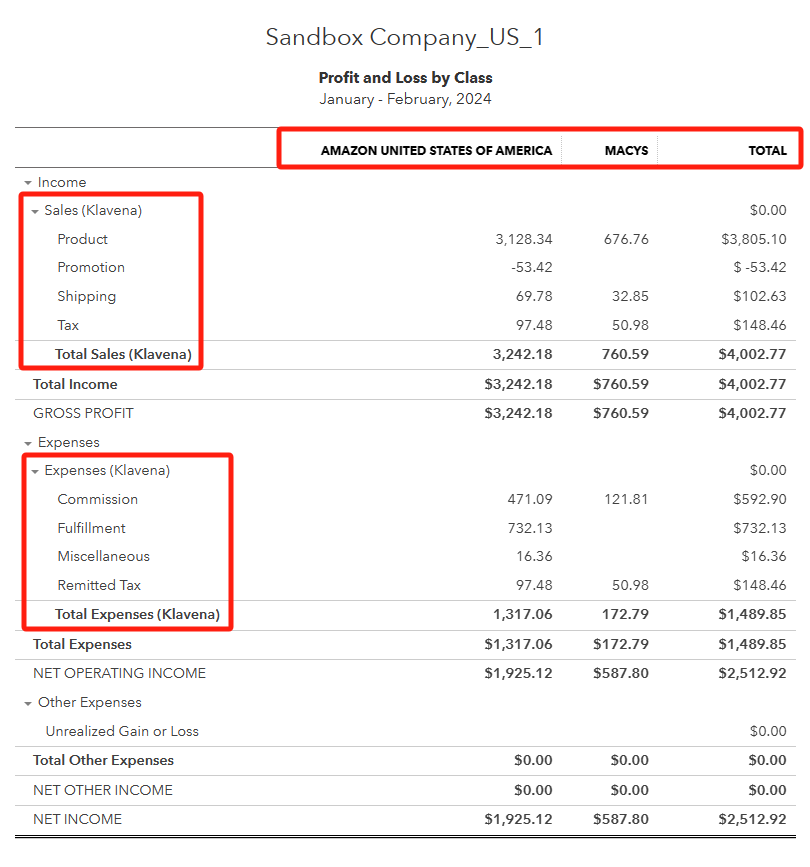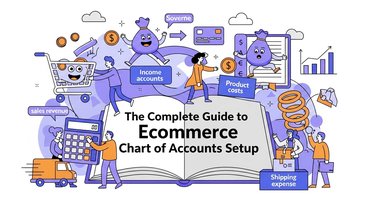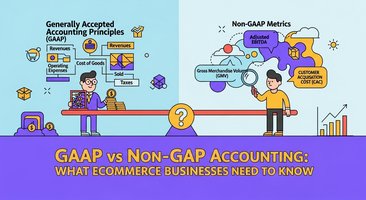What is E-commerce Accounting?
E-commerce accounting is the systematic recording, measuring, and communication of financial information for online businesses. Unlike traditional brick-and-mortar stores, e-commerce accounting involves unique challenges like:
- Multiple sales channels (Amazon, eBay, Shopify, Etsy)
- Digital payment processing (PayPal, Stripe, Amazon Pay)
- Complex fee structures (platform fees, payment processing, advertising)
- Inventory management across multiple locations
- International transactions and currency conversions
The Bottom Line
E-commerce accounting isn't just about tracking sales—it's about understanding your true profitability across all channels and making data-driven decisions to grow your business.
Pro Tip: Tools like Klavena automatically sync your sales data from multiple platforms directly into QuickBooks, eliminating manual data entry and reducing errors by up to 95%.
Why E-commerce Accounting is Different
1. Revenue Recognition Complexity
Unlike traditional retail, e-commerce revenue recognition involves:
- Marketplace fees deducted before you receive payment
- Refunds and returns processed weeks after the sale
- Subscription models with recurring revenue
- Multiple currencies for international sales
2. Multi-Channel Complexity
Managing finances across platforms means:
- Different payout schedules (Amazon bi-weekly, eBay daily, Shopify daily)
- Varying fee structures for each platform
- Platform-specific metrics that don't always align
- Consolidated reporting requirements for tax purposes
[Image Suggestion: Flowchart showing data from Amazon, eBay, Shopify flowing into Klavena, then into QuickBooks]
Essential E-commerce Accounting Concepts
1. Cost of Goods Sold (COGS)
COGS for e-commerce includes:
- Product cost from supplier
- Shipping to your warehouse (freight-in)
- Storage fees (FBA, 3PL)
- Direct labor for packaging/handling
Formula: COGS = Beginning Inventory + Purchases - Ending Inventory
2. Gross Profit Margin
Your gross profit margin shows profitability before operating expenses:
Formula: Gross Profit Margin = (Revenue - COGS) ÷ Revenue × 100
E-commerce Benchmark: Healthy e-commerce businesses typically maintain 40-60% gross margins.
3. Cash Flow vs. Profit
Critical Distinction: You can be profitable but cash-poor due to:
- Inventory purchases requiring upfront cash
- Platform payment delays (Amazon reserves, eBay holds)
- Seasonal fluctuations in sales
- Growth investments in inventory and marketing
Setting Up Your E-commerce Accounting System
Step 1: Choose Your Accounting Method
Accrual Basis Accounting (Recommended)
- Record transactions when they occur (regardless of payment)
- Best for: E-commerce businesses with inventory
- Pros: Shows true business performance, required for inventory
- Cons: More complex than cash basis
Why Accrual for E-commerce: With inventory, marketplace timing differences, and complex fee structures, accrual accounting provides a more accurate picture of your business performance.
Step 2: Set Up Your Chart of Accounts (The Klavena Way)
Based on thousands of successful e-commerce integrations, Klavena automatically creates an optimized chart of accounts structure in QuickBooks:
Assets
- Bank Accounts
- Checking Account
- Savings Account
- Amazon Balance
- eBay Balance
- Shopify Balance
- Etsy Balance
- Other Assets
- Inventory Asset
- Prepaid Expenses
Income (Sales) - Organized by Platform
Sales (Klavena) - Main income account
- Product - Product sales across all platforms
- Shipping - Shipping charges collected
- Tax - Sales tax collected
- Promotion - Promotional credits/income
- Other - Miscellaneous income
For each marketplace (Amazon, eBay, Shopify, etc.), Klavena creates specific items like:
- Amazon Product
- Amazon Shipping
- eBay Product
- eBay Shipping
- And so on...
Cost of Goods Sold
- Cost of Goods Sold - Product costs and direct expenses
Expenses - Organized by Platform
Expenses (Klavena) - Main expense account
- Commission - Platform commission fees
- Fulfillment - FBA and fulfillment fees
- Storage - Storage and warehousing fees
- Advertising - Platform advertising costs
- Miscellaneous - Other platform-specific expenses
Liabilities
- Sales Tax Payable - By marketplace
- Amazon Sales Tax Payable
- eBay Sales Tax Payable
- Shopify Sales Tax Payable
- Accounts Payable
- Credit Cards

Why This Structure Works
- Platform Separation: Each marketplace has its own balance account and specific items
- Automated Categorization: Transactions automatically go to the right accounts
- Clean Reporting: Easy to see performance by platform
- Tax Compliance: Proper sales tax tracking by jurisdiction
- Scalability: Structure grows with your business
Step 3: Connect Your Sales Channels
Manual Method (Not Recommended):
- Download sales reports from each platform
- Import into QuickBooks monthly
- Time required: 4-8 hours per month
- Error risk: High (data entry mistakes, missed transactions)
Automated Method with Klavena:
- One-time setup connects all your sales channels
- Real-time synchronization of sales, fees, taxes, refunds
- Time required: 30 minutes setup, then automatic
- Error risk: Minimal (automated categorization, built-in validation)
What Klavena Automates:
- ✅ Sales receipts for each transaction
- ✅ Refund receipts for returns
- ✅ Expense categorization (fees, advertising, storage)
- ✅ Sales tax tracking by jurisdiction
- ✅ Inventory adjustments (if enabled)
- ✅ Bank transfers and deposits
Daily Accounting Tasks for Online Sellers
✅ With Klavena (5 minutes daily)
- Check dashboard for any sync alerts
- Review yesterday's performance across all platforms
- Monitor cash flow and upcoming payouts
- Check for any refunds or unusual transactions
✅ Manual Tasks (Still Required)
- Save receipts for business expenses
- Track mileage for business trips
- Document business meals and entertainment
- Record cash transactions immediately
🚫 Without Automation (60+ minutes daily)
- Download sales reports from each platform
- Manually enter transactions into QuickBooks
- Calculate and categorize fees
- Track refunds and adjustments
- Reconcile payment processor deposits
Monthly and Quarterly Responsibilities
📅 Monthly Tasks
Week 1: Review Automated Data
- Verify Klavena synchronization across all platforms
- Review automated categorizations for accuracy
- Check for any sync errors or missing data
- Reconcile bank accounts (much easier with automation!)
Week 2: Manual Adjustments
- Add manual expenses not captured automatically
- Record cash transactions and offline sales
- Adjust inventory if tracking manually
- Review and approve any flagged transactions
Week 3: Financial Analysis
- Generate P&L by platform using Klavena's reporting
- Analyze gross margins by product category
- Review cash flow and upcoming obligations
- Compare performance month-over-month
Week 4: Planning & Tax Prep
- Review sales tax obligations by state
- Plan inventory purchases based on cash flow
- Set aside tax payments (25-30% of profit)
- Update financial projections
📊 Quarterly Tasks
Financial Statements Review
With Klavena's automated data, your QuickBooks reports are always current:
- Profit & Loss by Platform - See which channels are most profitable
- Balance Sheet - Track assets, liabilities, and equity
- Cash Flow Statement - Understand money movement
- Sales Tax Reports - Ready for filing in each jurisdiction
Tax Planning
- Quarterly estimated payments (if required)
- Sales tax filings by state
- Review deductions and business expenses
- Plan year-end tax strategies
Tax Considerations for E-commerce
Sales Tax Compliance
E-commerce sales tax is complex, but Klavena helps by:
- Automatically tracking sales tax collected by platform
- Separating tax by jurisdiction for easy reporting
- Creating tax liability accounts for each marketplace
- Generating reports for tax filing
Income Tax Planning
Key Deductions for E-commerce:
- Product costs (COGS)
- Platform fees and commissions
- Advertising expenses
- Storage and fulfillment fees
- Home office expenses
- Business equipment and software (including Klavena!)
Quarterly Responsibilities
- Estimated tax payments (if self-employed)
- Sales tax filings in applicable states
- Payroll taxes (if you have employees)
- Review tax withholdings and adjust as needed
Common E-commerce Accounting Mistakes
1. Not Tracking Platform Fees Separately
Mistake: Recording gross sales without accounting for platform feesSolution: Klavena automatically separates fees from net sales
2. Mixing Personal and Business Expenses
Mistake: Using personal accounts for business transactions
Solution: Dedicated business accounts for each platform
3. Ignoring Sales Tax Obligations
Mistake: Not collecting or remitting sales tax properly
Solution: Automated sales tax tracking by jurisdiction
4. Poor Inventory Management
Mistake: Not tracking COGS accurately
Solution: Proper inventory accounting (Klavena can help with this too)
5. Manual Data Entry Errors
Mistake: Relying on manual entry from multiple platformsSolution: Automated synchronization eliminates 95% of data entry errors
Choosing the Right Accounting Software
QuickBooks Online (Recommended for E-commerce)
Pros:
- Industry standard for small businesses
- Excellent integration capabilities
- Robust reporting features
- Works seamlessly with Klavena
Cons:
- Monthly subscription cost
- Learning curve for beginners
Why QuickBooks + Klavena is the Winning Combination
- QuickBooks provides the accounting foundation
- Klavena handles the e-commerce complexity
- Together they create a complete solution that scales with your business
Alternative Options:
- Xero: Good alternative to QuickBooks
- Wave: Free option for very small businesses
- FreshBooks: Better for service businesses
When to Hire a Professional
DIY with Klavena (Up to $500K revenue)
- Automated data sync handles most complexity
- Built-in categorization reduces errors
- Clean reports make tax prep easier
- Cost-effective for growing businesses
Consider a Bookkeeper ($500K - $2M revenue)
- Monthly reconciliation and review
- Advanced financial analysis
- Tax planning and preparation
- Klavena makes their job easier and more accurate
Hire a CPA ($2M+ revenue)
- Strategic tax planning
- Advanced business structuring
- Audit preparation
- Financial forecasting and analysis
Getting Started: Your 30-Day Action Plan
Week 1: Foundation
- [ ] Open dedicated business bank accounts
- [ ] Sign up for QuickBooks Online
- [ ] Connect Klavena to your sales channels
- [ ] Let Klavena create your chart of accounts
Week 2: Automation
- [ ] Verify all platforms are syncing correctly
- [ ] Review automated categorizations
- [ ] Set up sales tax tracking
- [ ] Configure inventory settings (if applicable)
Week 3: Analysis
- [ ] Generate your first automated P&L report
- [ ] Review performance by platform
- [ ] Identify top products and profit margins
- [ ] Set up monthly reporting schedule
Week 4: Optimization
- [ ] Fine-tune account mappings if needed
- [ ] Set up automated reports
- [ ] Plan tax strategy
- [ ] Schedule monthly review process
Conclusion
E-commerce accounting doesn't have to be overwhelming. With the right structure and tools like Klavena, you can:
✅ Automate 95% of data entry across all sales channels
✅ Maintain accurate financial records in real-time
✅ Generate professional reports for taxes and analysis
✅ Scale your accounting as your business grows
✅ Focus on growing your business instead of managing spreadsheets
Ready to streamline your e-commerce accounting? Try Klavena free for 14 days and see how automation can transform your business finances.
Frequently Asked Questions
Q: Can I use cash basis accounting for my e-commerce business?
A: While possible for very small businesses, accrual accounting is recommended for e-commerce due to inventory requirements and timing differences between sales and payments.
Q: How often should I reconcile my accounts?
A: Monthly reconciliation is standard, but with Klavena's real-time sync, your data is always current, making reconciliation much faster.
Q: Do I need separate accounts for each sales channel?
A: Klavena creates separate balance accounts for each platform automatically, which helps with cash flow management and platform-specific analysis.
Q: What's the biggest mistake new e-commerce sellers make?
A: Not setting up proper accounting from the start. Manual processes that work at $10K/month become impossible at $100K/month.
Q: How much should I set aside for taxes?
A: Generally 25-30% of profit for federal and state taxes, plus sales tax obligations. Klavena's reporting makes it easy to calculate these amounts.
Want to see how Klavena can simplify your e-commerce accounting? Sign up with Klavena and discover why thousands of sellers trust Klavena to manage their multi-channel finances.





